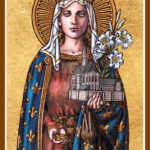
St. Zita
Saint Zita
When they lived: St. Zita, also known as Santa Zita, lived from 1212 to April 27, 1272.
Where they lived: St. Zita lived in the city of Lucca in Tuscany, Italy, for most of her life.
Notable world events during the time of their life:
- 1215 – The Fourth Lateran Council: This significant Catholic Church council addressed various aspects of church organization and doctrine, including the doctrine of transubstantiation and regulations for clergy conduct.
- 1248 – Building of Cologne Cathedral Begins: The construction of Cologne Cathedral, a masterpiece of Gothic architecture, began in this year. This cathedral would go on to be a lasting symbol of medieval craftsmanship and engineering prowess.
- 1265 – Birth of Dante Alighieri: One of Italy’s most celebrated poets, Dante Alighieri, was born in this year. His epic poem “Divine Comedy” would later become a cornerstone of Italian literature.
- 1271 – Marco Polo’s Travels Begin: The Venetian merchant and explorer Marco Polo embarked on his famous journey to the East, introducing Europe to the wonders and cultures of the Far East.
- 1271 – The Eighth Crusade: Led by Louis IX of France, the Eighth Crusade aimed to recapture the Holy Land. Although it ultimately did not achieve its objectives, it marked a significant event in the ongoing series of Crusades.
Patronage: St. Zita is widely recognized as the patron saint of housekeepers, domestic servants, and lost keys. Her life story is particularly associated with her unwavering dedication to her work as a domestic servant. Despite her humble status, she demonstrated remarkable compassion and charity toward the poor, often sharing her own meals and belongings with those less fortunate. Her story serves as an inspiration for those in similar professions and for anyone seeking to find holiness in their daily tasks.
Early Life
Zita was born in the year 1218 in Monsagrati, a village in Tuscany. This village was very close to Lucca. At the very tender age of twelve, she went on to become a servant in the Fatinelli household, about eight miles away from her home. The Fatinelli family was into the wool and cotton business and was prosperous in it. She worked for the Fatinelli household for forty-eight years until her death at the age of sixty.
Zita was from a poor family, but her parents were very devoted Christians. Her sister later became a nun, while her uncle, Graziano, became a saintly hermit.
Servanthood and Lifestyle
She served the Fatinelli household devotedly and did it with religious dedication. She believed that her genuine service was an act of worship to God and should be done well.
Despite her hectic schedule, Zita was still very prayerful. She maintained a life of prayer and fasting. She attended mass regularly at the church of San Frediano. Zita gave out all the good food she received as her ration to the poor and hungry. She had no care for what she wore. She gave out most of her clothes and was always seen with tattered clothes. Even in the wintertime, she didn’t care about footwear.
Because of her lifestyle, she was greatly despised by her fellow servants. They constantly insulted her and persecuted her for her uprightness. She was also humiliated by her employers despite her diligence and loyalty. For a while, they maltreated her, but Zita was not affected by this. She remained patient and didn’t complain on any occasion. She saw all her suffering as an opportunity to endure, just as Christ had endured. She remained patient and never once lost her peace.
One time there was famine, and many people had no food to eat and no means to survive. St. Zita was moved by the afflictions of the poor in society. She decided to give out beans from her master’s store without informing him. She gave out the beans to the poor and hungry. Not long after, her master, after seeing that the price for the beans had gone higher, decided that it was time to sell and make a huge profit. Zita was scared that he would find out that the quantity of beans had reduced in size. Much to her amazement, when the master went into the store, there was no decrease in the quantity of the beans. The bag showed no sign as though something had been taken from it. This was indeed a miracle.
Not long after, Zita became loved by every member of the household. Soon, she was made the chief housekeeper. Despite this, she still carried out her duty with vigor and dedication.
Death and Canonization
Zita lived a fulfilled life. She served the Fatinelli household until her death on April 12, 1272. On the night she died, a star rose above her room in the attic. She died at the age of 60. She was dearly loved and adored by the Fatinelli family.
Her body was exhumed in 1580 and found to be incorruptible. The body is displayed in the Basilica di San Frediano for public veneration.
Zita was canonized in 1696 after more than 150 miracles were reported to have taken place due to her intercession.
Veneration
A cult grew in her name after her death. The cult was centered at the Basilica of San Frediano in Lucca. Pope Innocent XII formally approved this cult in 1696. She is known as the patron Saint of domestic workers.
Her feast day is observed on April 27.
Prayer to St. Zita
St. Zita inspires us to take pride in our daily work and do it to the best of our abilities out of Love for God. May we find Jesus in the most menial of tasks. May we always embrace a spirit of obedience and charity, as you did. Pray for us, St. Zita, that we may have a generous heart that gives even when we have little. Place a trust in Jesus deep in our hearts so that we may never experience despair or loss of hope. Please carry the petitions we hold in our hearts to Jesus on our behalf. Mention your intentions here. Amen.
Source: https://www.catholicdoors.com/prayers/novenas/p03684.html



